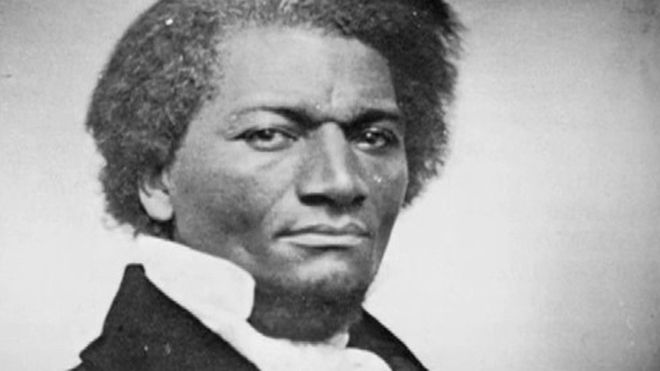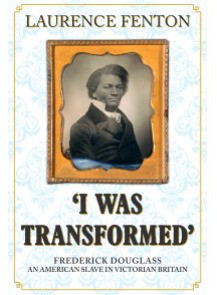After the Frederick Douglass event in the city on Bank Holiday Monday (28 May, 2018) in which BRHG members took part and which drew several hundred people we are publishing this article by Laurence Fenton. Laurence has just written a new book on the African American abolitionist’s visits to Victorian Britain and is calling for a more permanent memorial to this important moment in the history of the city and the struggle against slavery. BRHG fully support this initiative.
While actions from the naming of Pero’s Bridge after a Caribbean slave almost twenty years ago to the unveiling of plaques commemorating the abolitionist Thomas Clarkson’s stay in Bristol are marks of a city attempting to acknowledge and learn from its slave-trading past, the on-going controversy surrounding the renaming of Colston Hall shows how fraught the process remains. This year’s bicentenary of the birth of the American abolitionist Frederick Douglass, however, presents an opportunity to recall another side to Bristol’s engagement with the issue of slavery, the famous escaped slave receiving tremendous support from the city when he visited during a lecture tour in the 1840s.
Douglass had crossed the Atlantic after being advised to leave America until the furore over his incendiary autobiography, Narrative of the Life of Frederick Douglass, an American Slave, died down. He arrived in Bristol in late August 1846, the rail journey from London taking him through rolling West Country hills dappled with fabulous mansions built from the proceeds of slavery, Bristol having long served as the hub of the powerful West India planter interests. Met off the train by John Bishop Estlin, the 28-year-old slave was conveyed by horse-drawn carriage to the spacious 47 Park Street home the eye surgeon shared with his 25-year-old daughter Mary. The elder Estlin, the son of the highly-regarded Unitarian minister John Prior Estlin, was one of Bristol’s most respected citizens, combining a lucrative medical career with a lifetime’s dedication to philanthropic causes such as the education of the poor and the abolition of slavery. Mary was even more involved in the anti-slavery scene, becoming a leading member of the Bristol and Clifton Ladies’ Anti-Slavery Society.
While Douglass spent his first night in Bristol at the home of John Estlin’s Quaker friend George Thomas, the founder of Bristol General Hospital, he was back at Park Street the next morning for a busy breakfast with dozens of the ophthalmologist’s friends before Mary Estlin escorted him to the nearby Blind Asylum, where visually impaired people were trained for employment in crafts such as basket- and mat-making. The ‘pupils’ there, ‘about 60 men, women & children’, had already had his Narrative read aloud to them. ‘Their delight was extreme to feel him & question him. I think F.D. will never forget the scene,’ John Estlin wrote, the underlining of ‘feel’ suggesting they actually placed their hands on Douglass’s striking face and features.
From the Blind Asylum, Douglass made his way to an afternoon meeting at the Victoria Rooms, a handsome Greek revival-style building that had opened in 1842 – the foundation stone having been laid on Queen Victoria’s birthday in 1838 – and that now houses the University of Bristol’s Department of Music. John K. Haberfield, the popular mayor, chaired the meeting, noting Douglass’s Narrative had been ‘extensively read in this city’. He also filled a glass of water for Douglass at one point, leading a local paper to declare in mock outrage: ‘What! A white man – a mayor – a man in authority – hand a glass of water to a Negro! Incredible!’
When Douglass took to the stage, he acknowledged it was difficult for many in Britain to believe what he said about the horrors of slavery, because they ‘had heard of America, 3000 miles off, as the land of the free and the home of the brave’. The truth, however, was that despite all the loud talk of all men being equal, the constant sound in the South was of the ‘clank of the fetters and the rattling of the chains which bound their miserable slaves together, to be driven by the lash of their driver on board the ships for New Orleans, there to be sold in the market like brutes’. His well-honed ability to engage audiences to the fore, he then pointed to child near the front the crowd as he exclaimed: ‘And was he not a vagabond – when he would, without remorse, steal yon bright-eyed boy … tear him from his mother’s arms … doom him to slavery … and force him to drag his chains and fetters under the degrading torture of the lash?’ The boy was white, but the point was made. And besides, Douglass suggested to the crowd, the slaveholder ‘would steal white men as readily as a man who stole a black horse would not scruple to steal a white horse’.
Douglass sat down to ‘long-continued cheering’, wrote the local press. Mary Carpenter, a friend of the Estlins and a famous social reformer in her own right, could not remember a speech of such ‘powerful reasoning … touching appeals, keen sarcasm & graphic description’.
After a drive out to the countryside in Estlin’s carriage, Douglass returned to 47 Park Street that evening for another private gathering, the forty or so guests comprised in the main of ‘ministers, lawyers and merchants’. The following day he was back on a public stage, speaking to a 1,000-strong audience of ‘a more popular cast’, the 6d cost of the tickets doing little to temper the eagerness of the crowd, many of whom were forced to stand in the aisles throughout, to listen to his eloquent denunciations of slavery.
Thrilled with the response to his talks and with the friendship of the Estlins and others, Douglass would return to Bristol several times during his ‘liberating sojourn’ in Britain, finally travelling back to America in the spring of 1847 as not only a free man – his manumission purchased by a group of British supporters – but a celebrity and icon of international standing. He would go on to advise President Abraham Lincoln in the White House during the American Civil and is now widely regarded as the most influential African-American of the nineteenth century.
The Estlins remained committed to the anti-slavery cause, John Estlin actually passing away in 1855 in the midst of an anti-slavery meeting being held in his home. Mary Estlin, meanwhile, would campaign for the advancement of African-Americans until her death in 1902, by which time she had moved to the leafy surrounds of 36 Upper Belgrave Road in Clifton. Perhaps it is time they were remembered more formally in their much-loved city? A blue heritage plaque commemorating Douglass’s visit could also serve as a more positive counterpoint to the myriad reminders of the slave-trading Edward Colston throughout the city. The Victoria Rooms, where Douglass spoke so passionately, seem an obvious location.
Laurence Fenton’s ‘I Was Transformed’ Frederick Douglass: An American Slave in Victorian Britain is published by Amberley. www.laurencefentonbooks.com.

